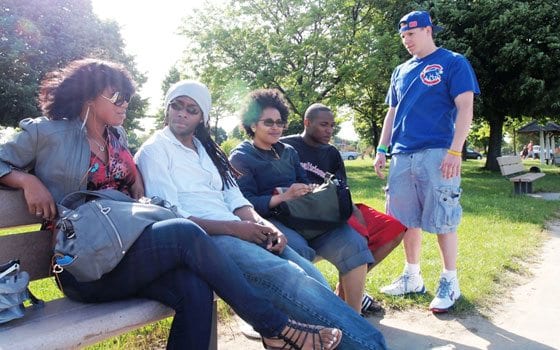
UMass Boston student Dion Marsman was enjoying the warm weather when the now-infamous fight broke out at Carson Beach.
According to reports, about 1,000 teenagers converged on the beach, prompted by facebook postings. A fight broke out between two girls, then two groups of boys joined in. State police moved in and ordered teens in the area to leave.
Newsmedia reports circulated speculating whether, as State Police asserted, there was gang involvement. To Marsman, nothing much out of the ordinary happened.
“They’re making a big deal out of nothing,” he said. “There are fights everywhere in the city, not just here.”
Catching a late afternoon breeze on a bench with four friends, Marsman said the beach is generally a safe place to hang out with friends.
“It’s rare that you experience anything here,” he said. “Anything bad that happens is under wraps.”
In the days following the incident, Boston Police Superintendent Ed Davis sought to gain jurisdiction over the beach, which is currently state property. Last Thursday, Davis met with State Police officials, MBTA Police and UMass Boston Police to agree on a joint policing strategy.
Media reports on the melee drew comparisons to the racially charged Carson Beach of the ‘70s, where white Dorchester and South Boston residents threw rocks at black beach-goers who were protesting the de-facto segregation of the area.
But Sen. Jack Hart, who called the meeting of police officials last Thursday, said there have been fights and incidents of rowdy behavior in the last four years.
“We had an Asian gang issue, but we also had a problem with our own kids,” he said, without elaborating on the difference.
In the decades since the ‘70s South Boston’s beaches have become thoroughly integrated.
“You see Indians, blacks, whites, Hispanics,” says Elizabeth, a Liberian-born customer services representative, who asked that her last name not be used. “There are a lot of different colors here. Everybody gets along.”
The neighborhoods around Carson Beach have changed as well. Dorchester is now only 22 percent non-Hispanic white. South Boston, which in the ‘70s was more than 90 percent white, is now 75 percent white.
South Asians, Vietnamese, Latinos and African Americans all live in the neighborhoods abutting Carson Beach — in the market-rate and subsidized units in the Harbor Point housing development and in the Old Colony and Mary Ellen McCormack Boston Housing Authority developments.
Many beachgoers like Marsman and his collegiate cohort take the Red Line to the JFK/UMass stop, a short walk from the surf.
Among those at the beach Saturday were several women in hijabs, a South Asian family with a barbeque grill and a white family with a volleyball net.
Although the beach has evolved to reflect modern-day demographics, the police jurisdiction lines have remained frozen in the past.
Boston police are now conducting joint patrols with State Police at Carson Beach and in the Seaport District. But despite Boston Police Commissioner Ed Davis’s call for Boston Police to take over jurisdiction of Carson Beach, both those areas will for now remain under the jurisdiction of the State Police.







